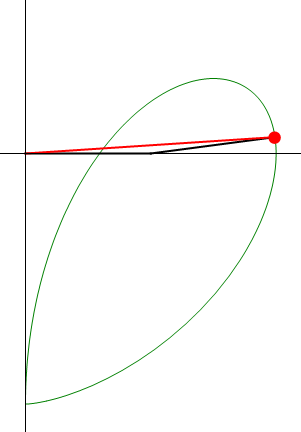2.3. Movimiento de partícula sujeta de un hilo
De Laplace
Contenido |
1 Enunciado
Una barra rígida AB de longitud L se mueve en un plano vertical OXY, manteniendo su extremo A articulado en un punto del eje horizontal de coordenadas  , y verificando la ley horaria θ(t) = 2ωt, con
, y verificando la ley horaria θ(t) = 2ωt, con  y siendo ω = cte. Un hilo inextensible de longitud 2L tiene uno de sus extremos conectado al origen del sistema de referencia (punto O), mientras que del otro cuelga una partícula P que mantiene al hilo siempre tenso. El hilo se apoya sobre una pequeña polea de radio despreciable situada en el extremo B de la barra, de forma que el tramo
y siendo ω = cte. Un hilo inextensible de longitud 2L tiene uno de sus extremos conectado al origen del sistema de referencia (punto O), mientras que del otro cuelga una partícula P que mantiene al hilo siempre tenso. El hilo se apoya sobre una pequeña polea de radio despreciable situada en el extremo B de la barra, de forma que el tramo  permanece siempre paralelo al eje OY (ver figura). Se pide:
permanece siempre paralelo al eje OY (ver figura). Se pide:
- Ecuaciones horarias del punto P,
 .
.
- Instante del tiempo tM en que la partícula alcanza su altura máxima.
- Radio de curvatura de la trayectoria seguida por P, en el instante considerado en el apartado anterior.
2 Ecuaciones horarias
La posición del punto P puede escribirse como suma de tres vectores

donde

y

El vector  es vertical hacia abajo y con un módulo igual a
es vertical hacia abajo y con un módulo igual a

siendo

Por tanto

y el vector de posición buscado es

En función del tiempo quedan las ecuaciones horarias

3 Instante de máxima altura
El instante de máxima altura se alcanza en el momento en que la componente vertical de la velocidad se anula.
La velocidad en cada instante es
![\vec{v}(t)=\frac{\mathrm{d}\vec{r}}{\mathrm{d}t}=2L\omega\left[-\mathrm{sen}(2\omega t)\vec{\imath}+\left(\cos(2\omega t)-\mathrm{sen}(\omega t)\right)\vec{\jmath}\,\right]](/wiki/images/math/8/2/7/827b5778291c1b2e88804efc340562a3.png)
La componente y se anula cuando





Esto es, la máxima altura se alcanza cuando la barra forma un ángulo de π/3 = 60° con la horizontal.
4 Radio de curvatura
Para el radio de curvatura necesitamos la aceleración en ese instante. Derivando de nuevo
![\vec{a}(t)=\frac{\mathrm{d}\vec{v}}{\mathrm{d}t}=-2L\omega^2\left[2\cos(2\omega t)\vec{\imath}+\left(2\,\mathrm{sen}(2\omega t)+\cos(\omega t)\right)\vec{\jmath}\,\right]](/wiki/images/math/b/f/d/bfdef954ef0a8ac38a741c3468dd91a8.png)
En el instante de máxima altura, la aceleración vale

La velocidad en ese mismo instante es

Puesto que la velocidad es puramente horizontal, la aceleración normal es la componente vertical

Esto nos da el radio de curvatura









